
Duke of Osuna is a Spanish noble title that was first awarded in 1562 by King Philip II of Spain to Pedro Girón de la Cueva,. Pedro was also Viceroy of Naples, (1582–1586), Ambassador in Portugal and 5th Count of Ureña.

Duke of Gandía is a title of Spanish nobility that was first created in 1399 by Martin of Aragon and granted to Alfonso of Aragon and Foix. It has its origin in the lordship of Gandía created in 1323 by James II of Aragon. Later, having no direct descendants, the title passed from the House of Barcelona to the House of Trastámara.

Francisco de Borja Téllez-Girón y Pimentel, 10th Duke de Osuna, Grandee of Spain, , was a Spanish nobleman.
Don Adolfo Ruspoli y Godoy, de Khevenhüller-Metsch y Borbón, dei Principi Ruspoli was a Spanish aristocrat, son of the prince Camillo Ruspoli and wife Carlota de Godoy y Borbón, 2nd Duchess of Sueca.

Duke of Escalona is a hereditary title in the peerage of Spain, accompanied by the dignity of Grandee and granted in 1472 by Henry IV to Juan Pacheco, 1st Marquess of Villena.

Duke of the Infantado is a Spanish peerage title that was granted to Diego Hurtado de Mendoza y Figueroa, son of Íñigo López de Mendoza, 1st Marquis of Santillana, by the Catholic Monarchs, Ferdinand II of Aragon and Isabella I of Castile, on 22 July 1475.
The Mayordomo mayor was the Officer of the Royal Household and Heritage of the Crown of Spain in charge of the person and rooms of the King of Spain. The Office of “Mayordomo mayor” was suppressed after the proclamation of the Second Spanish Republic in 1931 and never re-created after the restoration of the Monarchy in 1975, but it can be said that it is the historical precedent of the modern Head of the Royal Household of Spain.

Pedro de Alcántara Téllez-Girón y Beaufort Spontin, 11th Duke of Osuna, GE, was a Spanish peer, head of the House of Osuna. He was one of the most important peers of his time, and was thirteen times a duke, twelve a marquess, thirteen a count and once a viscount.

Duke of Béjar is a hereditary title in the Peerage of Spain, accompanied by the dignity of Grandee and granted in 1485 by the Catholic Monarchs to Álvaro de Zúñiga, 1st Duke of Plasencia and chief justice of Castile.

Duke of Benavente is a hereditary title in the Peerage of Spain, accompanied by the dignity of Grandee and granted in 1473 by Henry IV to Rodrigo Alonso Pimentel, 4th Count of Benavente.

José Gabriel de Silva-Bazán y Waldstein, 10th Marquess of Santa Cruz de Mudela, was a Spanish noble, first director of the Prado Museum between 1817 and 1820 and Mayordomo mayor between 1822 and 1823.
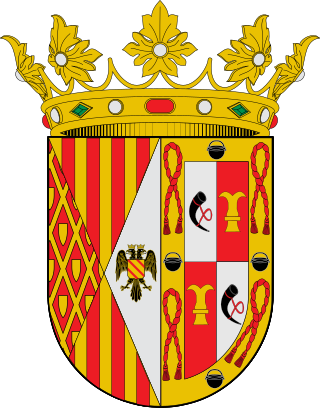
Duke of Mandas y Villanueva, commonly known as Duke of Mandas, is a title of Spanish nobility that is accompanied by the dignity of Grandee of Spain. It was granted along with the Marquessate of Terranova to Pedro Maza de Lizana on 23 December 1614 by king Philip III.

Count of Villada is a hereditary title in the peerage of Spain, granted in 1625 by Philip IV to Enrique Pimentel, a Spanish statesman who was son of the 2nd Marquess of Távara.
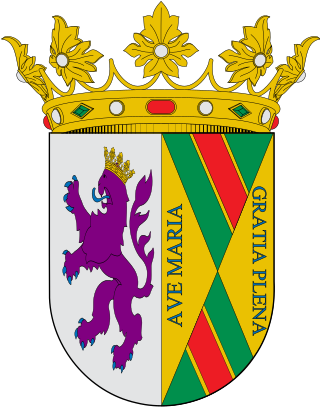
Duke of Pastrana is a hereditary title in the Peerage of Spain, accompanied by the dignity of Grandee and granted in 1572 by Philip II to Ruy Gómez de Silva, 1st Prince of Éboli, 1st Duke of Estremera and one of the king's advisors.

Mariano Téllez-Girón y Beaufort Spontin, 12th Duke of Osuna, GE, OM, LH, OAN, KA, was a Spanish peer, diplomat and army officer, whose lavish exploits as Ambassador of Spain to the Russian Empire earned him admiration and popularity amongst European courts. He was a younger brother of Pedro de Alcántara Téllez-Girón, from whom he inherited his 59 peerage titles when he died prematurely in 1844.
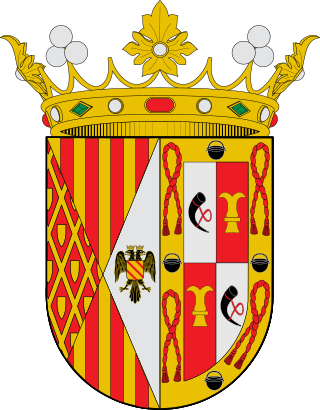
Marquess of Terranova, is a title of Spanish nobility. It was granted along with the Dukedom of Mandas to Pedro Maza de Lizana on 23 December 1614 by king Philip III.
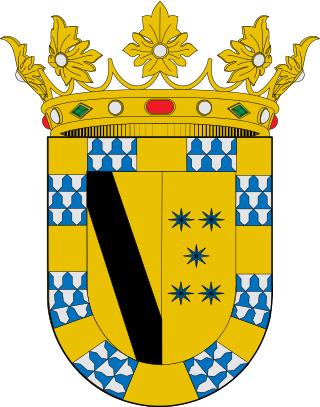
Duke of Lerma is a hereditary title in the Peerage of Spain accompanied by the dignity of Grandee, granted in 1599 by Philip III to Francisco Gómez de Sandoval, 4th Count of Lerma and his royal favourite.
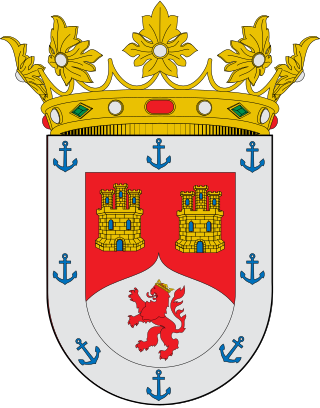
Duke of Medina de Rioseco is a hereditary title in the Peerage of Spain, accompanied by the dignity of Grandee and granted in 1538 by Charles I to Fernando Enríquez de Velasco, Admiral of Castile and Lord of Medina de Rioseco.

Duke of Estremera is a hereditary title in the Peerage of Spain, accompanied by the dignity of Grandee and granted in 1538 by Philip II to Ruy Gómez de Silva, 1st Prince of Éboli.

Marquess of Almenara is a hereditary title in the Peerage of Spain, granted in 1587 by Philip II to Iñigo López de Mendoza, his representative in the Kingdom of Aragon.


















